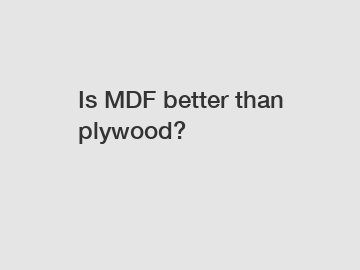Jan. 16, 2024
Construction
Is MDF Better Than Plywood?
When it comes to choosing the right material for furniture or interior decor projects, there are various options available in the market. Amongst them, Medium-Density Fiberboard (MDF) and plywood are two widely used choices. Both materials have their own set of advantages and disadvantages. However, the question remains: Is MDF better than plywood? Let's explore this topic in depth and analyze the properties and applications of both materials to reach a conclusion.
1. Composition:

MDF, as the name suggests, is made from fine wood fibers combined with resin and wax. These fibers are compressed under high pressure to form solid sheets. On the other hand, plywood consists of multiple thin layers of wood veneers, which are glued together under pressure. The number of layers can vary, but the more layers there are, the stronger the plywood becomes.
2. Strength and Durability:
Plywood is generally considered stronger and more durable than MDF due to its layered structure. The cross-grain pattern of the veneer layers adds strength and prevents warping or splitting. Plywood is also known for its excellent resistance to moisture, making it a suitable choice for outdoor applications. However, MDF also possesses decent strength and durability, making it suitable for interior projects.
3. Cost-effective:
MDF is often more cost-effective compared to plywood. This is mainly because it is made from recycled wood fibers, making it an eco-friendly option. Additionally, the manufacturing process of MDF is less complex, which further contributes to its lower price. Plywood, being made from thin layers of high-quality raw material, tends to be slightly more expensive.
4. Finish and Workability:
One of the significant advantages of MDF over plywood is its superior finish. MDF has a smooth and consistent surface, which makes it ideal for painting or laminating. It also holds screws and nails well without splitting. On the other hand, plywood may have a rougher surface, which may require additional finishing work or sanding before painting. However, plywood is generally known to have better tensile strength, making it a preferred choice for applications requiring high load-bearing capacity.
5. Fire Safety:
While both MDF and plywood are combustible materials, their fire resistance differs. MDF tends to release more smoke and toxic fumes when exposed to fire, making it less desirable in certain applications. Plywood, with its multiple layers, tends to resist fire better and is often used in construction or furniture where fire safety is a concern.
6. Environmental Impact:
When it comes to environmental factors, both MDF and plywood have pros and cons. MDF is made from recycled wood fibers, reducing the demand for new raw materials. It also eliminates the need for solid wood cutting, thus reducing deforestation. However, MDF contains adhesives that may emit formaldehyde, a harmful volatile organic compound (VOC). In contrast, plywood is made from natural wood, but the production process involves more waste and uses more energy compared to MDF.
In conclusion, the choice between MDF and plywood depends on the project requirements and personal preferences. While plywood offers better strength, durability, and fire resistance, MDF provides a smoother finish, cost-effectiveness, and lower environmental impact. Consider the intended use, budget, and desired aesthetics before making a decision. Ultimately, the right choice will vary from project to project, ensuring the best outcome for your specific needs.
Want more information on is birch plywood waterproof, Marine plywood for wet areas, Melamine plywood maintenance? Feel free to contact us.
Previous: What is the principle of space frame structure?
Next: Dive into Exquisite Glass Pool Tiles: Style, Durability & Easy Maintenance!
If you are interested in sending in a Guest Blogger Submission,welcome to write for us!
All Comments ( 0 )